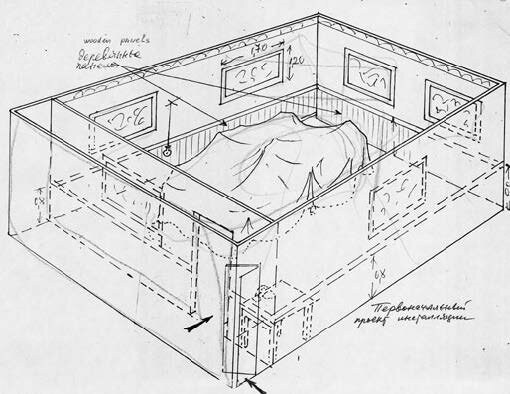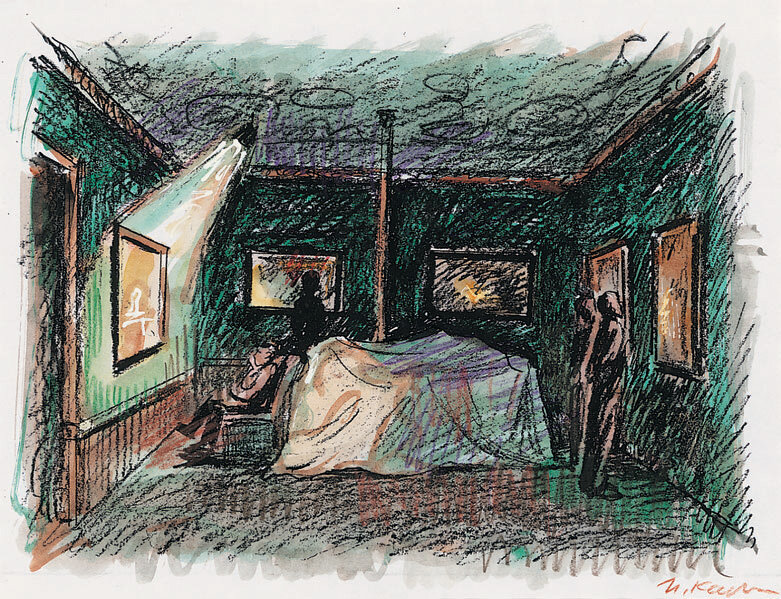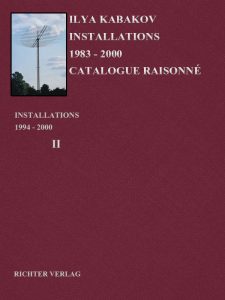For Sale!
YEAR: 1994
CATALOGUE NUMBER: 77
PROVENANCE
The artist
1994, Collection Fundación La Caixa, Madrid
EXHIBITIONS
Madrid, Fundación La Caixa
Topominias: Ocho Ideas del Espacio, 1 February 1994 — 10 April 1994
Barcelona
Caixa Forum Exhibition Opening, 27 February 2002
CONCEPT AND DESCRIPTION OF THE INSTALLATION
The viewer enters through a dark room in a relatively small dwelling where there is rather a strange lighting and a rather strange interior. This is an ancient hall with a golden cornice at the top, with dark green walls and dark panels along the walls. Along the walls are hanging six paintings in dark frames under glass. In the center of the room is furniture all clustered together – couches, tables, armchairs – all covered from the dust with a large white throw. The inhabitants of the room, as it becomes clear immediately, have left and the entire contents are for sale.
The entire essence of the installation is in the lighting. The room is immersed in darkness, but the light coming from the lamp falls only on one painting which is hanging to the left of the entrance. On it is depicted ‘wonderful Rome,’ a marvelous landscape which is visible in the light right down to the smallest detail. But simultaneously in the half-darkness of the room, the viewer sees himself as well, standing in the room, and the other ‘visitors’ and the strongly illuminated painting. The other five paintings along the walls ‘work’ as mirrors. In each one, thanks to the glass, emerges the amazing world of the installation, since the illuminated painting is superimposed onto the figure of the viewer himself and onto the depiction of that which is located in the frame under glass. This mysterious effect ‘works’ in different ways depending on the approach of the viewer to the other paintings: what emerges before him is an amazing world, a ‘beyond-the-mirror’ world. The lighting effect is exaggerated even more by the presence of still another source of light: a lamp standing on the table to the right of the entrance.
Inside the installation, it is possible for the viewer to walk around the furniture placed in the center. One can also sit: one of the couches in the middle is placed specially to sit comfortably just opposite the ‘wonderful Rome painting’ which is well lit, and to submerge oneself into its contemplation and into the atmosphere of deep tranquility and concentration and reminiscence …
The thing is that this installation, For Sale!, was done especially for Spain, or more precisely, for Madrid, where the disappearance of the ancient, old interiors is actually still relevant today; the internal spaces are disappearing, parental ‘nests’ are being torn apart, and what was supposed to be passed on via inheritance, to move into the future without change, is now perishing, being destroyed, being sold. The installation falls into this context: the Spanish viewer immediately grasps the content here that is familiar to him – the wonderful past, departing into darkness, into the chaos of a neglected family home, with furniture covered with a white shroud and the shining of a sunny Madrid day on a painting that looks simultaneously like a painting and also like a window into that wonderful, sparkling past.
Images
Literature






